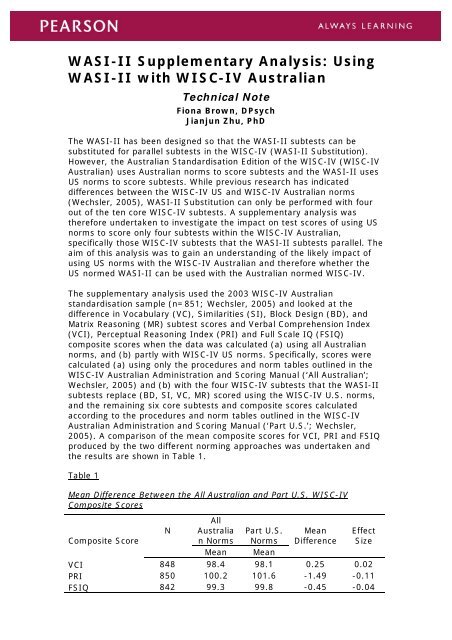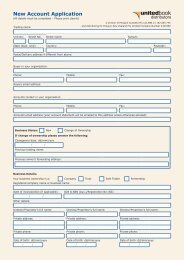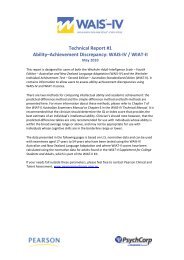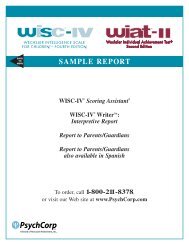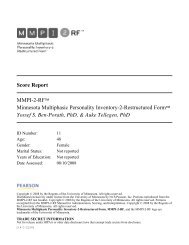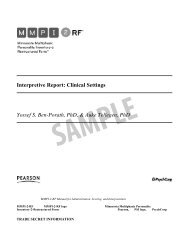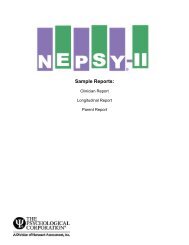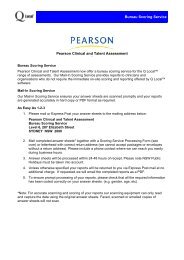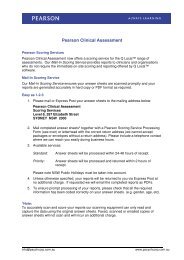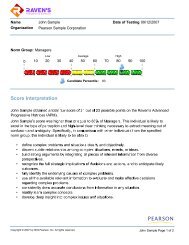WASI-II Supplementary Analysis Using WASI-II with WISC-IV Australian
Using WASI-II with WISC-IV Australian - Pearson - Clinical and ...
Using WASI-II with WISC-IV Australian - Pearson - Clinical and ...
- No tags were found...
Create successful ePaper yourself
Turn your PDF publications into a flip-book with our unique Google optimized e-Paper software.
<strong>WASI</strong>-<strong>II</strong> <strong>Supplementary</strong> <strong>Analysis</strong>: <strong>Using</strong><br />
<strong>WASI</strong>-<strong>II</strong> <strong>with</strong> <strong>WISC</strong>-<strong>IV</strong> <strong>Australian</strong><br />
Technical Note<br />
Fiona Brown, DPsych<br />
Jianjun Zhu, PhD<br />
The <strong>WASI</strong>-<strong>II</strong> has been designed so that the <strong>WASI</strong>-<strong>II</strong> subtests can be<br />
substituted for parallel subtests in the <strong>WISC</strong>-<strong>IV</strong> (<strong>WASI</strong>-<strong>II</strong> Substitution).<br />
However, the <strong>Australian</strong> Standardisation Edition of the <strong>WISC</strong>-<strong>IV</strong> (<strong>WISC</strong>-<strong>IV</strong><br />
<strong>Australian</strong>) uses <strong>Australian</strong> norms to score subtests and the <strong>WASI</strong>-<strong>II</strong> uses<br />
US norms to score subtests. While previous research has indicated<br />
differences between the <strong>WISC</strong>-<strong>IV</strong> US and <strong>WISC</strong>-<strong>IV</strong> <strong>Australian</strong> norms<br />
(Wechsler, 2005), <strong>WASI</strong>-<strong>II</strong> Substitution can only be performed <strong>with</strong> four<br />
out of the ten core <strong>WISC</strong>-<strong>IV</strong> subtests. A supplementary analysis was<br />
therefore undertaken to investigate the impact on test scores of using US<br />
norms to score only four subtests <strong>with</strong>in the <strong>WISC</strong>-<strong>IV</strong> <strong>Australian</strong>,<br />
specifically those <strong>WISC</strong>-<strong>IV</strong> subtests that the <strong>WASI</strong>-<strong>II</strong> subtests parallel. The<br />
aim of this analysis was to gain an understanding of the likely impact of<br />
using US norms <strong>with</strong> the <strong>WISC</strong>-<strong>IV</strong> <strong>Australian</strong> and therefore whether the<br />
US normed <strong>WASI</strong>-<strong>II</strong> can be used <strong>with</strong> the <strong>Australian</strong> normed <strong>WISC</strong>-<strong>IV</strong>.<br />
The supplementary analysis used the 2003 <strong>WISC</strong>-<strong>IV</strong> <strong>Australian</strong><br />
standardisation sample (n=851; Wechsler, 2005) and looked at the<br />
difference in Vocabulary (VC), Similarities (SI), Block Design (BD), and<br />
Matrix Reasoning (MR) subtest scores and Verbal Comprehension Index<br />
(VCI), Perceptual Reasoning Index (PRI) and Full Scale IQ (FSIQ)<br />
composite scores when the data was calculated (a) using all <strong>Australian</strong><br />
norms, and (b) partly <strong>with</strong> <strong>WISC</strong>-<strong>IV</strong> US norms. Specifically, scores were<br />
calculated (a) using only the procedures and norm tables outlined in the<br />
<strong>WISC</strong>-<strong>IV</strong> <strong>Australian</strong> Administration and Scoring Manual (‘All <strong>Australian</strong>’;<br />
Wechsler, 2005) and (b) <strong>with</strong> the four <strong>WISC</strong>-<strong>IV</strong> subtests that the <strong>WASI</strong>-<strong>II</strong><br />
subtests replace (BD, SI, VC, MR) scored using the <strong>WISC</strong>-<strong>IV</strong> U.S. norms,<br />
and the remaining six core subtests and composite scores calculated<br />
according to the procedures and norm tables outlined in the <strong>WISC</strong>-<strong>IV</strong><br />
<strong>Australian</strong> Administration and Scoring Manual (‘Part U.S.’; Wechsler,<br />
2005). A comparison of the mean composite scores for VCI, PRI and FSIQ<br />
produced by the two different norming approaches was undertaken and<br />
the results are shown in Table 1.<br />
Table 1<br />
Mean Difference Between the All <strong>Australian</strong> and Part U.S. <strong>WISC</strong>-<strong>IV</strong><br />
Composite Scores<br />
Composite Score<br />
N<br />
All<br />
Australia<br />
n Norms<br />
Mean<br />
Part U.S.<br />
Norms<br />
Mean<br />
Mean<br />
Difference<br />
Effect<br />
Size<br />
VCI 848 98.4 98.1 0.25 0.02<br />
PRI 850 100.2 101.6 -1.49 -0.11<br />
FSIQ 842 99.3 99.8 -0.45 -0.04
Given the large sample size used in the current study, t-tests were not the<br />
appropriate method for evaluating the mean differences. Instead, the<br />
effect size (e.g., Cohen’s d) was used to determine whether the mean<br />
differences were statistically meaningful. The resulting d statistics (effect<br />
sizes) ranged from 0.02 to -0.11 and according to Cohen’s (1988)<br />
descriptive scheme would be defined as trivial in size.<br />
A discrepancy analysis was also undertaken and Table 2 shows the<br />
cumulative frequencies of the discrepancies between the subtest and<br />
composite scores generated by the All <strong>Australian</strong> and Part U.S. norming<br />
approaches.<br />
Table 2<br />
Cumulative Frequency of Score Discrepancy between All <strong>Australian</strong> and<br />
Part U.S. Scores<br />
Scaled Scores<br />
Composite Scores<br />
BD SI VC MR VCI PRI FSIQ<br />
-5 0.1 1.2<br />
-4 1.4 11.9 0.1<br />
-3 2.7 14.1 0.8<br />
-2 13.2 60.7 11.9<br />
-1 45.6 17.7 3.6 27.0 16.3 43.7<br />
0 100.0 100.0 65.8 100.0 69.1 100.0 89.0<br />
1 100.0 73.4 100.0<br />
2 98.8<br />
3 100.0<br />
According to Table 2, the discrepancies for the four subtest scores were all<br />
equal to or less than 1 scaled score point, while 99.2%, 96.1% and 85.9%<br />
of the discrepancies for the FSIQ, VCI and PRI (respectively) were less<br />
than or equal to 2 standard score points.<br />
Overall, the finding indicate that the effect that resulted from using the<br />
<strong>WISC</strong>-<strong>IV</strong> US norms to score the four <strong>WISC</strong>-<strong>IV</strong> subtests (BD, SI, VC, MR)<br />
on the <strong>WISC</strong>-<strong>IV</strong> <strong>Australian</strong> VCI, PRI and FSIQ composite scores was<br />
negligible and will generally produce only small score differences. The<br />
impact on test scores of using the U.S. norms for the four parallel <strong>WASI</strong>-<strong>II</strong><br />
subtests (BD, SI, VC, MR) <strong>with</strong>in the <strong>WISC</strong>-<strong>IV</strong> <strong>Australian</strong> is also therefore<br />
likely to be negligible. Considering these findings indicate that the limited<br />
use of US <strong>WASI</strong>-<strong>II</strong> norms <strong>with</strong>in the <strong>WISC</strong>-<strong>IV</strong> <strong>Australian</strong> is likely to have a<br />
negligible impact on test scores, where appropriate, <strong>WASI</strong>-<strong>II</strong> Substitution<br />
can therefore be undertaken <strong>with</strong> the <strong>WISC</strong>-<strong>IV</strong> <strong>Australian</strong>.<br />
In terms of the procedures for <strong>WASI</strong>–<strong>II</strong> Substitution <strong>with</strong> the <strong>WISC</strong>-<strong>IV</strong><br />
<strong>Australian</strong>, these are the same as those outlined in the <strong>WASI</strong>-<strong>II</strong><br />
Administration and Scoring Manual and the technical report <strong>Using</strong> the<br />
<strong>WASI</strong>–<strong>II</strong> <strong>with</strong> the <strong>WISC</strong>®–<strong>IV</strong>: Substituting <strong>WASI</strong>–<strong>II</strong> Subtest Scores When<br />
Deriving <strong>WISC</strong>–<strong>IV</strong> Composite Scores (Zhu & Raiford, 2011).
References<br />
Cohen, J. (1988). Statistical power analysis for the behavioral sciences<br />
(2 nd ed.). Hillsdale, NJ: Lawrence Erlbaum Associates<br />
Wechsler, D. (2005). <strong>WISC</strong>-<strong>IV</strong> <strong>Australian</strong> standardisation edition. Sydney:<br />
Pearson Clinical and Talent Assessment.<br />
Zhou, X. & Raiford, S. E. (2011). <strong>Using</strong> the <strong>WASI</strong>–<strong>II</strong> <strong>with</strong> the <strong>WISC</strong>®–<strong>IV</strong>:<br />
Substituting <strong>WASI</strong>–<strong>II</strong> Subtest Scores When Deriving <strong>WISC</strong>–<strong>IV</strong> Composite<br />
Scores. Retrieved from<br />
http://www.pearsonassessments.com/hai/Images/Products/<strong>WASI</strong>%20<strong>II</strong>/<br />
<strong>WASI</strong>2_WAIS4%20Editorial_2.pdf.


